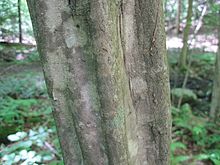Carpinus caroliniana
[3][4] It occurs naturally in shaded areas with moist soil, particularly near the banks of streams or rivers, and is often a natural constituent understory species of the riverine and maritime forests of eastern temperate North America.
Carpinus caroliniana (American hornbeam) is a small tree reaching heights of 6–10 meters (20–35 ft), and often has a fluted and crooked trunk.
The leaves are alternate, 3–12 centimeters (1+1⁄4–4+3⁄4 in) long, with prominent veins giving a distinctive corrugated texture, and a serrated margin.
There are two subspecies, which intergrade extensively where they meet: They are shade-loving trees, preferring moderate soil fertility and moisture.
[4] Varies from shrub to small tree, and ranges throughout the United States east of the Rocky Mountains.

